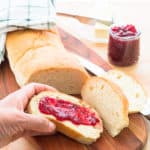
Pan Sobao
Servings: 24 servings (2 one pound loaves)
Calories: 197kcal
A soft, chewy bread that's a popular amongst the people of Puerto Rico. Begin a day in advance.
Print Recipe
Ingredients
Poolish (Sponge)
- 2 tablespoons warm water
- 2 tablespoons (16g) bread flour
- 1/8 teaspoons (1g) active dry yeast
Bread Dough
- 1 1/2 cups (350ml) warm water divided
- 3 tablespoons (37g) granulated sugar* see note
- 4 1/2 teaspoons (15g) active dry yeast (2 pkgs)
- 1/4 cup (51g) lard (or shortening)
- poolish
- 4 1/2-5 cups (615-680g) bread flour
- 1 1/2 teaspoons (8g) kosher salt
Instructions
Make the Poolish
- Make the poolish in a small mixing bowl by stirring together the bread flour, water, and yeast. Cover the bowl with plastic wrap, and allow this to sit at room temperature for eight hours. After eight hours, transfer it to the fridge for an additional twenty-four hours (or until ready to make your bread). Do not allow to ferment longer than 24 hours.
Make the Bread Dough
- An hour prior to mixing the bread dough, remove the poolish from the refrigerator and allow it to come to room temperature.
- In the bowl of a stand mixer, stir together 3 tbsp of the warm water, the sugar, and the yeast. Allow the yeast to bloom for five minutes.
- Add the fat and the room temperature poolish to the mix, followed by the rest of the warm water. Mix on medium speed for 2 minutes, or until combined, using the paddle attachment.
- With the mixer running on its lowest speed, gradually add 3 cups of flour to the mixture, followed by the salt. Once the mixture looks like a thick batter, change from the paddle attachment to the dough hook.
- With the mixer on low, gradually add the remaining flour to the bowl. Depending on your elevation and how humid the day is, you may use more or less flour than this recipe calls for. Allow the mixer to knead the dough for ten minutes. The dough will pull away from the sides of the bowl and begin climbing up the hook. The dough should be elastic and soft, but not sticky.
Ferment the Dough
- Remove the dough from the mixing bowl, lightly oil the bowl with a small amount of vegetable oil, and put the dough back into the bowl. Turn the dough over so the oiled surface is on top, then cover bowl with plastic film.
Place the bowl into an in an unheated oven, or in a microwave. Allow the bread to ferment for one hour or until it's doubled in size with the door closed.
Shape the Dough
- Punch down the dough after the fermentation time has elapsed to dispel the carbon dioxide that has developed in the dough. Fold the dough over itself, 3 or 4 times, to distribute the yeast and regulate the temperature of the dough. Invert the mixing bowl over the dough and allow it to relax for five minutes.
- Divide the ball of dough into two equal pieces. Use the sides of your cupped handsto rotate the dough into a smooth ball. Cover the dough with a kitchen or tea towel and allow the dough sit on the countertop for 10 minutes.
- Shape the dough into 12" logs by pushing the ball of dough back and forth between the fleshy parts of your hand and the countertop. After you've shaped the dough, put it onto a parchment-lined half sheet pan.Place the pan into your unheated oven, but this time turn the oven light on. Proof for 30 min- 1 hour, or until doubled in size. The dough should spring back slowly when you lightly touch its surface.
Bake
- While your dough is proofing, preheat your oven to 400°F. Place a cast iron skillet into the oven at the same time, placing it above, or beneath, an empty rack.
- Once the bread is done proofing, carefully, add two cups of ice to the cast iron skillet that's in the oven. Shut the door quickly to prevent too much steam from escaping and allow the steam in the oven to build up for five minutes. Quickly put the pan of proofed dough onto the empty oven rack and bake for 15-20 minutes, or until the bread is golden brown and sounds hollow when tapped.
- Once the bread has finished baking remove it from the oven and allow it to cool for five minutes. Remove it from the pan and set the loaves on a cooling rack to cool completely. Enjoy immediately or store* for later.
Notes
*A quick note about Pan Sobao: I've received comments about the sweetness of my pan sobao. Pan Sobao shouldn't be sugary-sweet. It should have some sweetness, but not so much so that it's detectible. That said, you if grew up on super-sweet pan sobao you may want to increase the amount of sugar to 1/4 cup or 1/2 cup. You'll need to decrease the baking temp by 5°F (395°F) to account for the excess sugar.
- Wrap individual loaves in plastic wrap and place into bread bags to freeze.
- Pan Sobao freezes well for two months.
Nutrition
Calories: 197kcal | Carbohydrates: 35g | Protein: 6g | Fat: 3g | Saturated Fat: 1g | Sodium: 122mg | Potassium: 53mg | Fiber: 1g | Sugar: 2g | Calcium: 7mg | Iron: 1mg